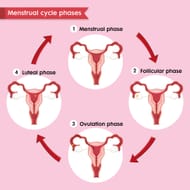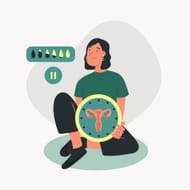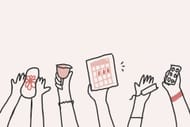The follicular phase of the menstrual cycle is the time leading up to ovulation. This phase is characterized by a rise in estrogen and fall in progesterone. It's also when the body prepares for pregnancy by creating a ripe environment for an egg that can be fertilized by a sperm.
If no pregnancy occurs, you will experience bleeding during the next part of your cycle — known as menses or menstruation. In this article, we will take a closer look at what happens during the follicular phase and what changes occur in the body during this period.
What is the follicular phase?

The follicular phase is the first half of the menstrual cycle. It begins on the first day of the period and ends on the day of ovulation.
This is when you experience more than one egg released from an ovary, which happens in response to a surge in luteinizing hormone (LH) produced by the pituitary gland.
The first part of this phase involves development and growth within one or more ovarian follicles - a fluid-filled sac that contains an oocyte (egg cell). When fully mature, each follicle releases its oocyte into another structure called the uterus via fimbriae (fingerlike projections).
When all's said and done, only one ovum survives; this process is called ovulation.
When does the follicular phase begin and end?

The follicular phase begins when you start ovulating and ends when you start bleeding. The exact length of this phase varies, but it's generally between 12 and 14 days.
The follicular phase can be broken down into three distinct phases: early (days 1-6), mid (days 7-12) and late (day 13).
Follicular phase of menstrual cycle

The follicular phase is the beginning of the menstrual cycle. It begins on day one, which is the first day of your period and ends with ovulation, which occurs around day 14.
The luteal phase is the second part of the menstrual cycle and begins on day 15 and lasts till you get your next period (called menstruation).
The total length of each phase depends on what happens during each phase. In general, both phases are about two weeks long. The follicular phase is 7-14 days long, while the luteal phase lasts 12-16 days.
What happens in the follicular phase?
This phase starts on the first day of your period and ends when ovulation occurs, which is typically 14 days later.
During this time, the body prepares for ovulation by releasing hormones that tell the ovaries to grow eggs and prepare them for release during ovulation.
1) Estrogen
The estrogen hormone levels rise steadily throughout this phase as they prepare the uterus (womb) for pregnancy. That happens even if you don't get pregnant, as it helps prevent endometrial cancer.
2) Ovulation

The release of an egg is called ovulation. It usually happens 14 days after the first day of your period and is a sign that you're fertile.
During this time, you may feel some pain in the lower abdomen or back, called mittelschmerz (German for 'middle pain'). That can be caused by pressure on a nerve while the egg is released from its follicle.
The follicular phase ends when you ovulate and begun producing progesterone and estrogen again.
3) Menses
Menses is the medical term for menstruation, which refers to the monthly discharge of blood and tissue from the uterus. The average length of a woman's menstrual cycle is 28 days, but it can range from 21 to 35 days.
As you can see, there's a lot going on during the follicular phase of the menstrual cycle. All these changes, from the rise and fall in hormones to all the necessary reactions that need to take place, are designed to make getting pregnant easier for women who might be trying to conceive.
